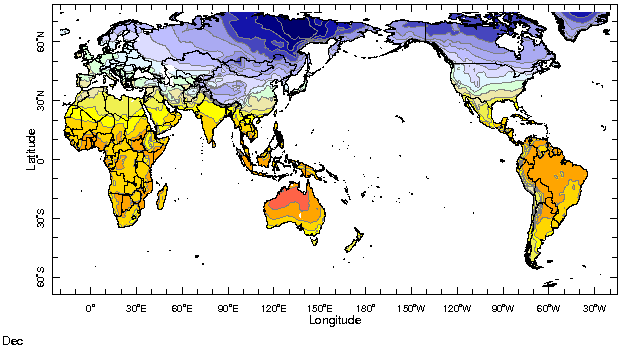|
IRI Climate Digest
January 2003
December Global Climate Summary
Climatological Background
In December, the Northern Hemisphere enters the heart of winter, with strong north-south temperature differences driving the mid-latitude jet stream and storm systems. In the Southern Hemisphere summer is under way, with monsoon systems gaining strength in South America, southern Africa, and Australia.
Monthly Mean Temperature (1961-1990), data from the Climate Research
Unit, University of East Anglia


Monthly Mean Precipitation (1961-1990), data from the Climate Research
Unit, University of East Anglia


Temperatures
Highlights
In December, a single wave dominated the Northern Hemisphere mid and high latitudes, shifting cold arctic air into northern and eastern Europe and much of northern and central Asia, while warmer-than-normal temperatures intensified in Alaska and eastern Russia, Canada, and the northern U.S. Warm anomalies continued in Australia, though diminished from November.
Temperature Difference from the 1961-1990 mean, with data
from NCEP Climate Prediction Center, CAMS.


Precipitation
Highlights
Precipitation patterns in several regions continued to be consistent with those typically seen during El Niņo events. These include unusually dry conditions in northern South America, the Caribbean, Indonesia, and eastern Australia. Meanwhile in December, the dry conditions in Southern Africa have shifted northward from South Africa into Mozambique and Zimbabwe, and the dry conditions in northwestern North America have shifted northward into British Columbia. The unusally wet conditions which continued across the southeastern US, southeastern South America, and East Africa are also typical during El Niņo.
Precipitation Difference from 1961-1990 mean, with data
from NCEP Climate Prediction Center, CAMS-OPI.


Oceanic Conditions
Tropical Pacific: El Niņo conditions continued during December, with the maximum sea surface temperature (SST) anomalies just east of the dateline remaining above 2.5°C. These conditions are expected to continue and begin to diminsh by March 2003. See the latest IRI ENSO Update for a detailed summary and outlook.
Tropical Atlantic: Near normal conditions continued to dominate the tropical Atlantic, but with slighly warmer than average temperatures developing off the West African coast.
Indian Ocean: Warming developed further in the central and western regions of the Indian Ocean, and the cold anomalies off the west coast of Australia diminished from those observed last month.
Mid latitudes: The warm anomalies in the Gulf of Alaska decreased in magnitude to 2.0°C and shifted northeast towards the North American coast. The warm anomalies off the southeast coast of South America continued to develop, and cold anomalies across the southern Atlantic moved eastward, off the South American coast.
Monthly Sea Surface Temperature Difference from the 1950-1979 mean,
with data from the Environmental Modeling Center, NCEP/NOAA.


Contents |
Special |
Impacts |
Climate |
Forecast
|

